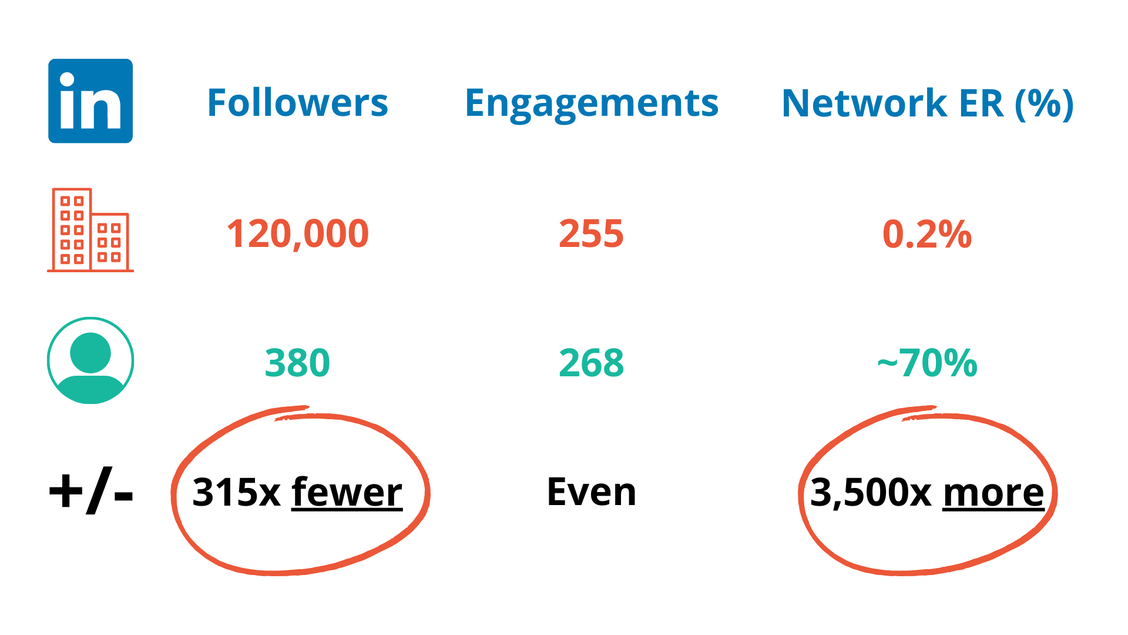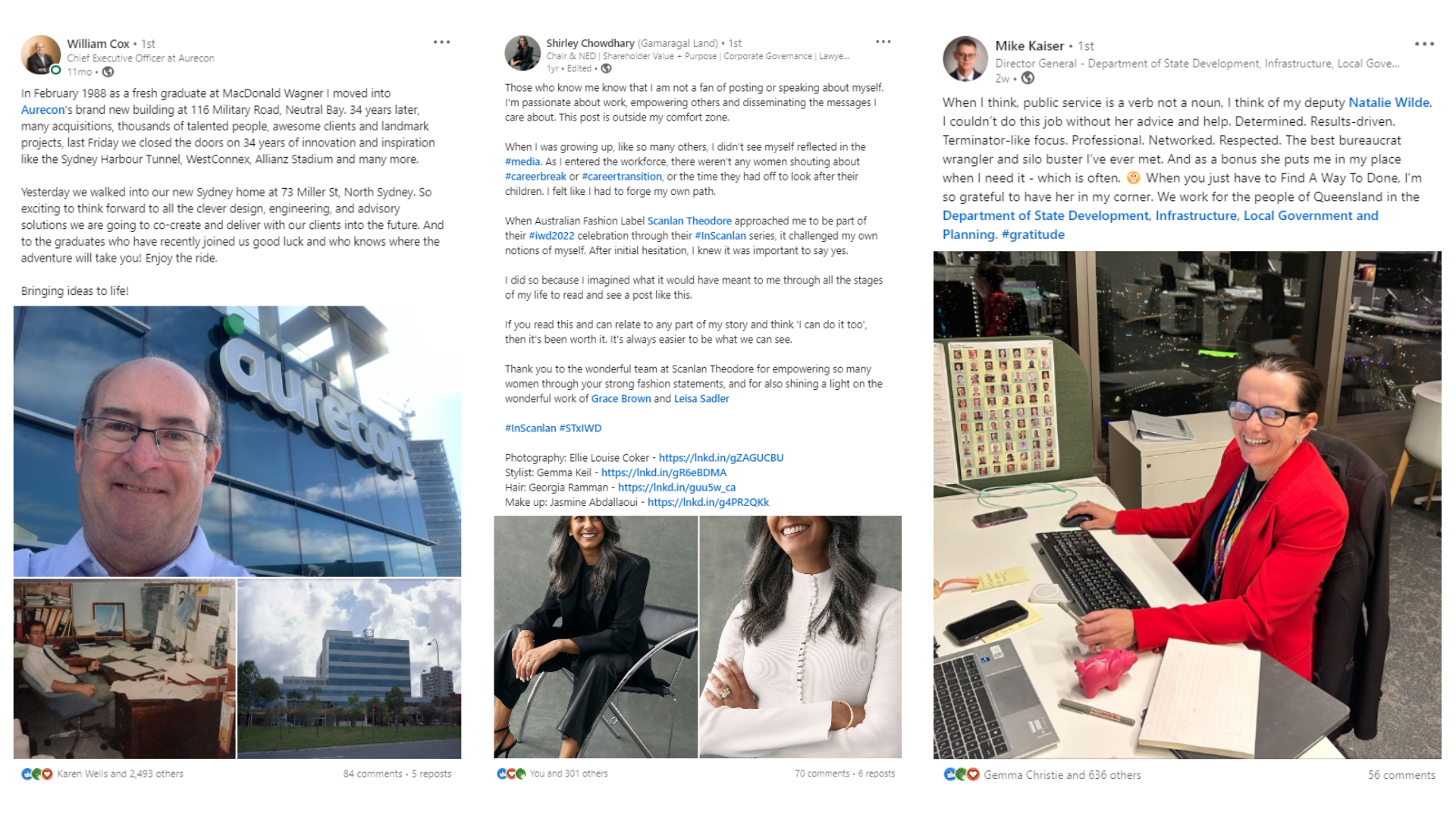
One question I get asked a lot by leaders is: ‘Why do I need to post on LinkedIn if my organisation already does?’
My answer likely goes against everything you’ve been told about social media (and comms more broadly, to be honest)… But LinkedIn is a unique beast.
So let me explain with some compelling data, and also share three leaders’ stories that highlight the immense power of your individual voice over your institution’s.
I’m certain you’ll come away with a fresh perspective on the value of your own efforts, and why leaders like you need to speak up online.

The above graphic reveals a fascinating opportunity for leaders within the exact same story.
(Note: in this example, ‘Followers’ is the number of people within a LinkedIn network, whether a Company Page or individual profile. ‘Engagements’ is the total number of reactions, comments and reposts generated. ‘Network ER’ is the number of engagements based on the known network – in this case, ‘Engagements’ divided by ‘Followers’ equals ‘Network Engagement Rate’.)
It’s a case study from a client we worked with – a major financial services institution – who was launching a major product enhancement.
The red information shows how that post performed when shared by the Company Page on LinkedIn.
The green information shows how the same post performed when the leader featured in the story shared it via his own LinkedIn profile.
The difference is profound.
The post shared by the leader with a 315x smaller network (compared with the Company Page) saw a 3,500x stronger network engagement rate.
Why? And what does this result mean for you?
That’s what I am (and hopefully you are!) most interested in.
Why individuals ALWAYS outperform institutions on LinkedIn.
This client case study is not a one off. There are some clear and systemic reasons this happens (and some equally clear reasons why you should flip the conventional ‘brand first, people second’ hierarchy for LinkedIn on its head).
1. Institutions can pay. LinkedIn is a business. It makes money, largely, from selling ads. Individual users are the targets of those ads, but corporations are the buyers. So, much like Facebook circa 2013, it’s in LinkedIn’s best interests to prioritise individual content ahead of Company Page content, where reach can be bought. (LinkedIn’s Thought Leader Ads are an emerging opportunity that blends the two – drop me a note if you’d like to talk about how they work.)
2. Individuals have context. Anyone can choose to follow a Company Page, but an individual connection request is two way. It requires context. You worked in the same team/business/industry, met at an event, or admired something someone did. You may have even mentioned this context in your connection request. It matters. That context is the very reason why you’re interested in what someone has to say. That context is why a leader with 380 connections can generate more engagement from their network than a page with 120,000 followers on the very same post.
3. Individuals can connect. Why is context important? Because it is the source of our relationships, why we care and what brings us together. That type of connection doesn’t come from generic brand posts. It comes from personalised comments, private messages, and knowing the meaning behind a personal post – not just the words used. It’s why a ‘like’ from the CEO means an awful lot more than a ‘like’ from the brand. Connection happens with other people, not businesses.
Hopefully you’re seeing the clear opportunity for you and your own voice on LinkedIn. So let’s see what it looks like in practice with three great examples.

Three examples from leaders that show the power of the personal voice.
1. Bill Cox’s lesson on nostalgia. This is a wonderful post about a humble office move. But, in it, Aurecon’s CEO shows the power of tapping into 30+ years of history and thousands of relationships. The comments remain the best ‘recruitment ad’ and employer branding I’ve ever seen.
The Company Page posted about the move too, to good effect. But note how the same story was shared a very different way. The lesson? Harness both.
2. Shirley Chowdhary’s lesson on courage. Some leaders don’t like the spotlight. Shirley’s one of those (sorry Shirl!). But, in this post, the Chair of Women for Election and The Australian Institute of Architects uses her voice and story as a source of encouragement to anyone who shares her self doubt.
It’s honest, it’s brave, it connects. On a personal level. Brands can’t do that.
3. Mike Kaiser’s lesson on authenticity. The only brand in the world that could legitimately use the phrase ‘Terminator-like focus’ is, well, The Terminator. But, in Mike’s case as Director-General in the Queensland Government, it’s an authentic and distinctive phrase that captures the sheer commitment and determination his colleague, Natalie, possesses.
Forget stock standard job ads on LinkedIn – when leaders talk about their people with this level of personalisation, care and context, those people will tell EVERYONE about how great it is to work with you.
What next?
What’s your voice? How is it distinctive from your organisation’s? What about your colleagues – how are their voices different, too?
Most importantly, are they all being harnessed?
If you’re relying on your brand – the Company Page – to do all the work, the results will be sub-par.
Effective modern leaders step out and (dare I say…) in front of the brand on LinkedIn to build context, connection and trust online. There’s 3,500 reasons why.
If you’d like a hand finding your own voice online, drop me note. It’s the most rewarding part of my job and I’d love to help.
Take care in the meantime,
Roge

Want more just like this delivered straight to your inbox? Subscribe below for all your latest digital reputation advice, trends and the best practice examples of the leaders getting it right online. We’d love to have you part of this growing community.